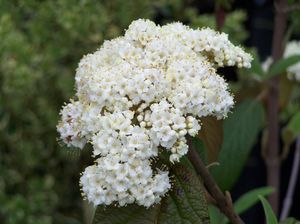View All Plants :: View All BROADLEAF EVERGREEN SHRUBS
Viburnum rhytidophyllum
Leatherleaf Viburnum
Plant Type:
BROADLEAF EVERGREEN SHRUBSViburnum rhytidophyllum – The Leatherleaf Viburnum is a wonderful, virtually evergreen plant in USDA zone 5b – guaranteed evergreen in warmer climes. Each rich, dark green sturdy leaf can be 7” long by 1” to 2.5” wide. They are heavily wrinkled, textured and, yes, leathery. Flower buds set up the previous season at the tips of branches; they are woolly in a buff-rust color, 1.5” to 2” across and rather attractive in the winter landscape. Yellow-white spring flowers are from 4” to 8” diameter with a faint scent. V. rhytidophyllum can make a very effective screen. Deep red berries turn black in autumn, both colors occurring simultaneously on the many drupes. It is beautiful as an evergreen element in a mixed deciduous planting. I seldom see this plant in eastern Connecticut and for the life of me cannot understand why?
Characteristics and Attributes for Viburnum rhytidophyllum
Season of Interest (Flowering)
- Spring
Season of Interest (Foliage)
- Four Seasons
Autumn Interest
- Showy Buds
- Fruit / Berries / Seed Heads
Nature Attraction
- Honey Bees & Native Bees
- Deer Resistant
- Songbirds
Light
- Morning Sun / Afternoon Shade
- Dappled Shade
- Shade
Attributes
- Shrub Border
- Woodland
- Hedge
- Evergreen
- Hedgerow
- Fragrant
- Wildlife Garden
- Specimen
- Screen
Growth Rate in the Garden
- Moderately Fast
Soil
- Moist
- Fertile
Origins
- China
Propagated By
- Cutting Grown
Genus Overview: Viburnum
Common Name: Viburnum
Viburnum. This genus is full of fantastic, multi-season garden worthy shrubs. Garden heroes. Spring flowers, often large and showy, many with heady sweet fragrance are arranged in cymes. Some smell of musk (Viburnum dilatatum) while others produce no fragrance at all. Flowers are followed with berries. If late season and autumn berries are desired then planting two of a species will ensure fruit set; for instance, Viburnum dilatatum 'Erie' and V. dilatatum 'Michael Dodge' will pollinate each other and produce fruit. Viburnum cassinoides is closely allied with V. nudum; but if the flowering times do not overlap then there will be no fruit. However, if you plant V. nudum 'Winterthur' in proximity with V. nudum var. angustifolium, 'Longwood', 'Moonshine' or 'Pink Beauty' berries will abound. Another interesting example is V. lantana which crosses with V. burejaeticum and vice versa. Any V. plicatum f. tomentosum selection such as 'Shasta' or 'Shoshoni' will pollinate with all other V. plicatum f. tomentosum selections like 'Copper Ridges or 'Pink Beauty'. But if you were to plant two 'Shasta' side by side with no other V. plicatum f. tomentosum in near proximity then your effort will be fruitless. As with almost all in the universe of plants there are exceptions. There is one viburnum which appears to be self-fruitful, Viburnum setigerum the Tea Viburnum. Another interesting exception to the rule is Viburnum nudum 'Pink Beauty' which is also self-fruitful - a departure from its siblings. And on the other spectrum are two I can think of off-hand that are barren, Viburnum plicatum 'Roseum' and Viburnum plicatum 'Kern's Pink'. Oftentimes, the dwarf viburnums reamin in a juvenile state and do not produce fruit. All Viburnum of any size that do produce fruit are magnificent in the late season garden. And they feed all manner of birds. Larger, denser shrubs provide cover and nesting opportunities. Nearly all Viburnum have terrific autumn foliage colors, too. Viburnums are members of Caprifoliaceae. All prefer part to full sun and fertile soils. All are cutting grown. Many thanks to Gary Ladman of Classic Viburnums who generously set us straight regarding some of the details we had originally incorrectly lauded... ya can't know everything!


